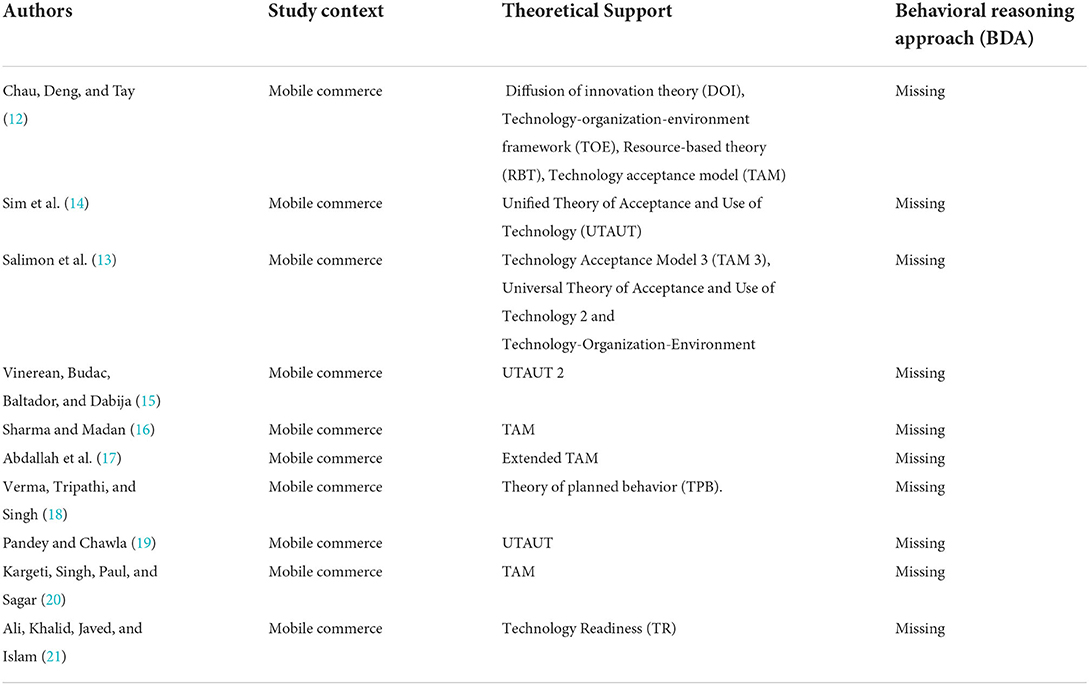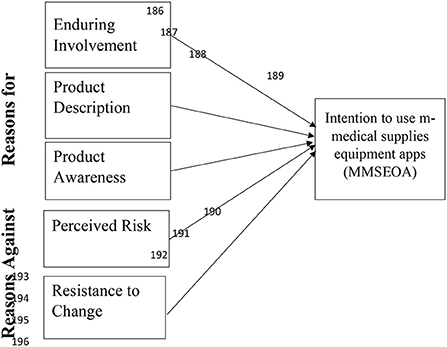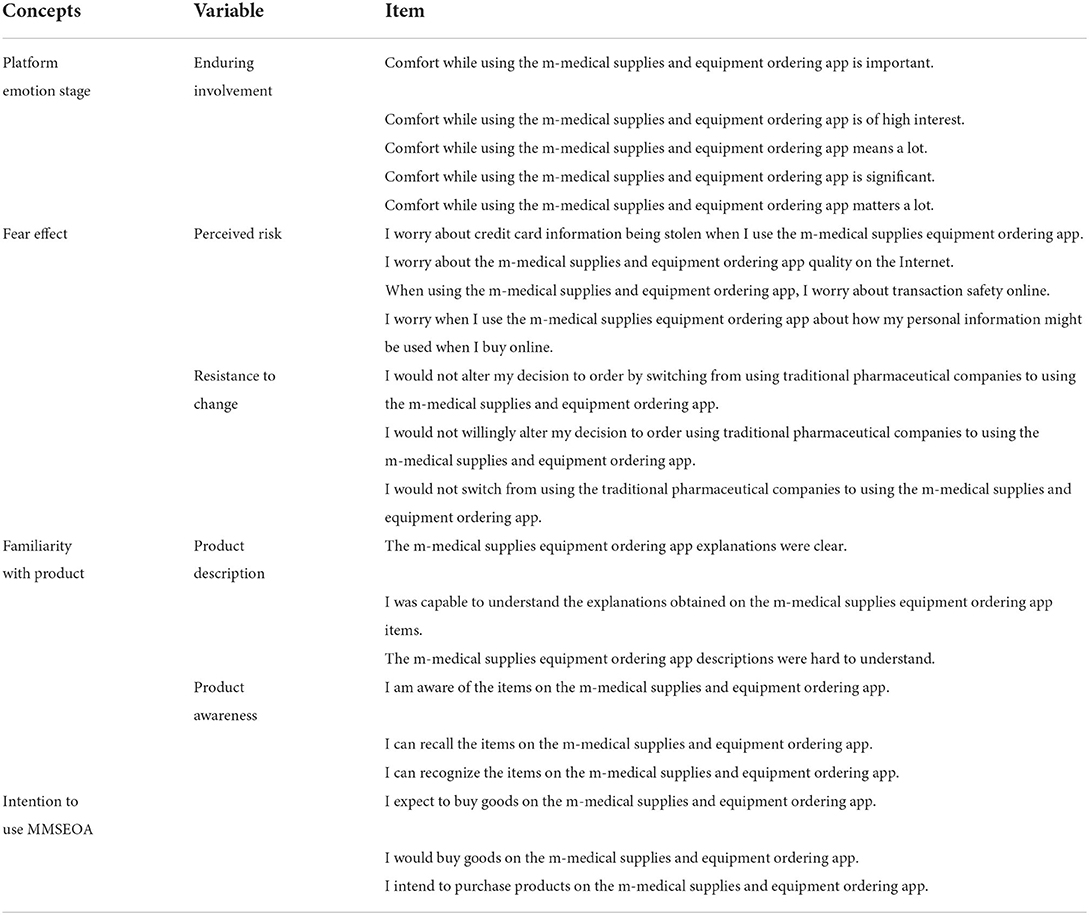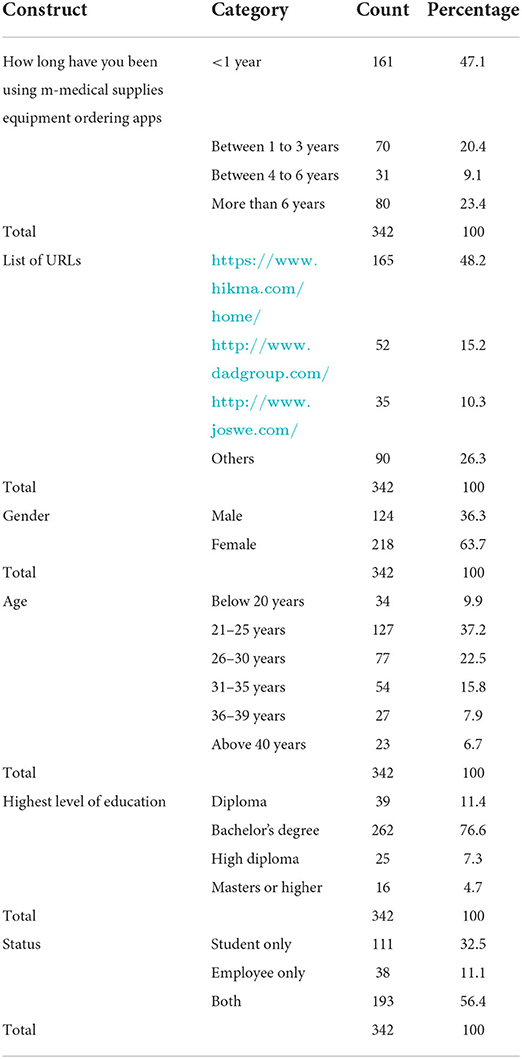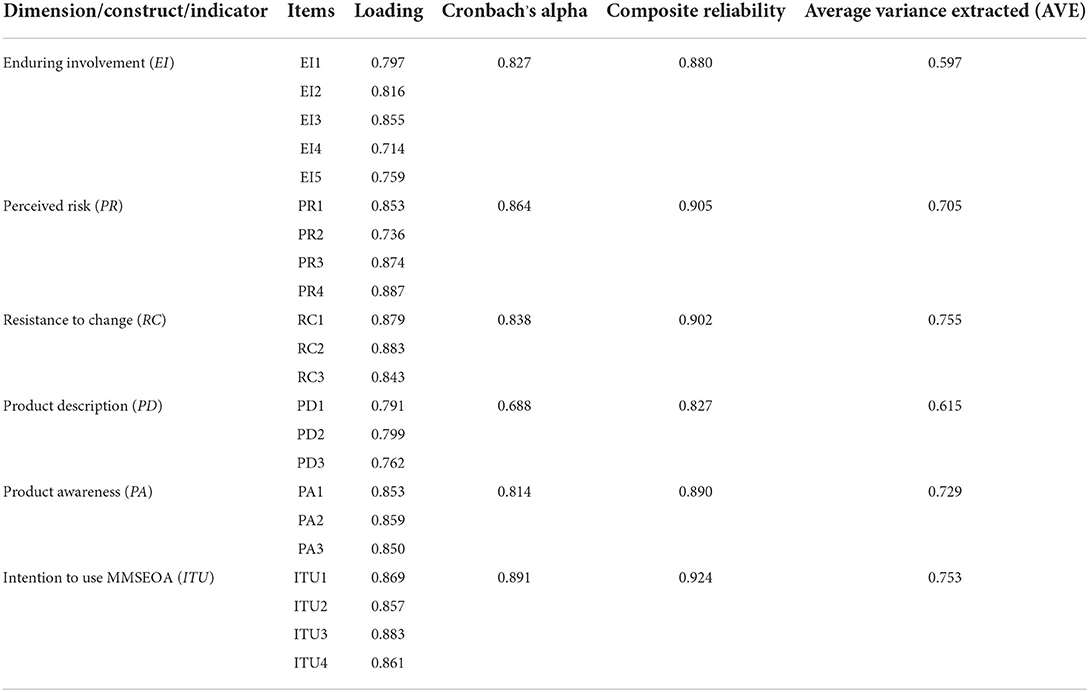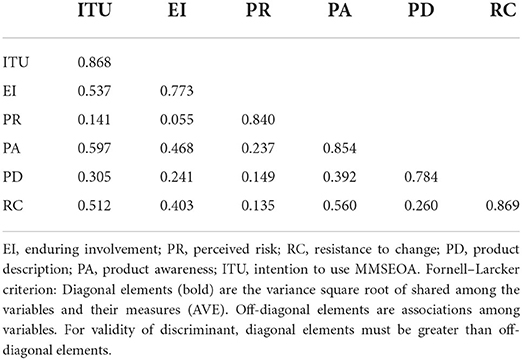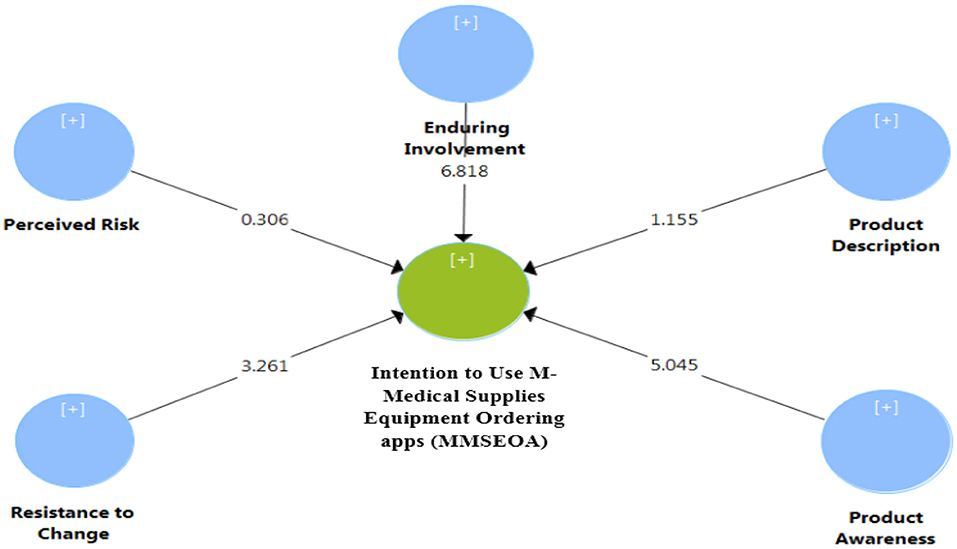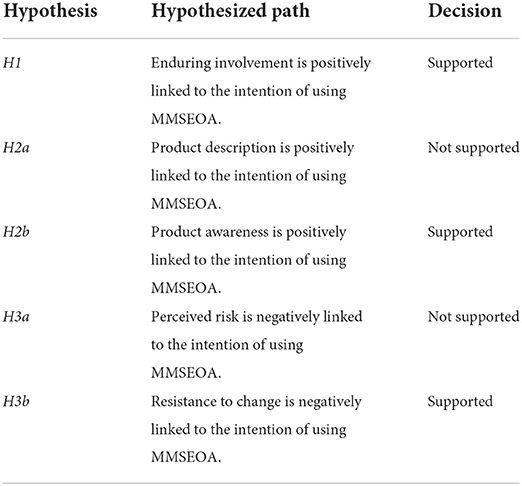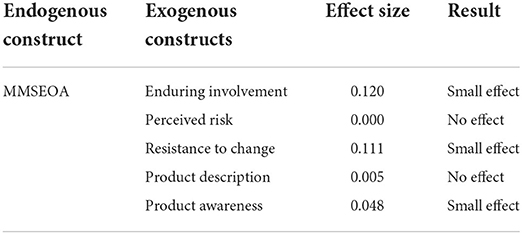- Department of Management Information Systems, College of Business Administration, Prince Sattam Bin Abdulaziz University, Al-Kharj, Saudi Arabia
This research developed a mobile medical supplies and equipment ordering app (MMSEOA) model and attempted to validate it empirically. When customers (clinic doctors) make purchases on the app, two types of reasons can be identified: “reasons for” include enduring involvement (emotions), product description, and awareness (familiarity) while the “reasons against”, were demonstrated as perceived risk and resistance to change (fear). This study aimed to strengthen and illuminate the most significant dimensions that enhance a doctor's understanding of MMSEOA and the intention to use it. Furthermore, this research investigated the model's applicability among clinic doctors in Jordan. The model was empirically examined using a sample of 342 Jordanian clinic doctors and their secretaries who use mobile services in general. The survey method, a quantitative approach, was utilized; the partial least squares structural equation modeling system was used to investigate the proposed framework. The results demonstrate that these “reasons for” positively influenced the intention to use the MMSEOA except product description. Similarly, reasons against negatively influence the customers' intention to use the MMSEOA app, while perceived risk had no effect on the intention to use. These findings suggested that researchers should focus more on the services, products, and the main function of the MMSEOA to determine their influences on customers' intention to use. This will improve the buying habits related to purchasing medical supplies using MMSEOA and other online platforms, specifically in Jordan and the Middle East at large.
Introduction
Compared to traditional commerce, there is growing interest in mobile commerce services, also known as m-commerce. M-commerce has necessitated new approaches to advertising (1, 2). It affords every nation, business, and individual major business opportunities from a global perspective (3, 4). Furthermore, m-commerce facilitates the activities of small and medium enterprises (SMEs), which have also adopted m-commerce, similar to big enterprises, to develop their operations; m-commerce facilitates a strong relationship between retailers and end-users (5, 6).
M-commerce also plays a new role in the business world, affecting marketers and companies. It facilitates various business activities such as shopping, sports, advertisements and gaming (7). Variables related to the facilitating conditions, such as culture and/or telecommunications infrastructure, are also influenced by changing intentions to use m-commerce across countries (8). According to the Jordanian ICT Ministry, ~90% of Jordanian households have smartphones, 89% have Internet subscriptions, and 33% have computers (9). These indicators cannot provide enough understanding of m-commerce user attitudes. Therefore, to create suitable marketing tactics based on varying attitudes, it is necessary to comprehend the individual and environmental variables that determine the level of intention to use.
It can be assumed that all institutions, including businesses in Jordan, whether small or large and the government, have all the possible technological resources to effectively facilitate m-commerce (2). Jordan's strong telecommunication infrastructure enables businesses to connect to m-commerce services and adopt them for their activities. Furthermore, it can be observed that the number of services availed to smartphone users in Jordan by m-commerce is growing steadily. However, m-commerce will be worthless without mobile devices that can deal with digital data associated with digital communications (10).
Various drivers of the intention to use m-commerce services, such as perceived risk, compatibility, perceived usefulness, and perceived ease of use, have been identified in empirical studies (11). The extant literature examines the reasons for and barriers to technological acceptance by doctors and the adoption of mobile medical supplies and equipment ordering apps (MMSEOA) by different customers. Most prior research concentrated on examining the response to m-commerce adoption (12–14). In other words, earlier research has mostly considered the facilitators (reasons for) m-commerce adoption. Still, the equally essential barriers or inhibitors that create the customers' resistance toward using m-commerce have been rarely explored. However, a dearth of research examines both of these reasons within one framework (see Table 1). Claudy et al. (22) argued that researchers need to concentrate on identifying and examining the both acceptance and resistance factors for any invention or technology adoption behavior. According to social psychology research, these drivers of adoption and barriers factors are quantitatively different and influence the customers' consumption choices differently.
This research bridges this gap and contributes to the literature by employing the behavioral reasoning approach (BRA) to understand customers' intentions to use MMSEOA. The research model was developed based on behavioral reasoning approach (BRA) and tested by conducting a cross-sectional survey of 342 Jordanian customers (i.e., medical doctors). BRA enables the researchers to determine the relative impact of “reasons for” (i.e., acceptance factors) and “reasons against” (resistance factors) on customers' intention toward using MMSEOA. BRA is an emerging approach that offers a complete understanding of the different behavioral components of customers' intentions to use MMSEOA (23). This study investigated MMSEOA and the clinic doctor's intention to use it. Studying the attitude of clinic doctors toward this service will grant marketers insight into the perceived related challenges, the intention to use and customer satisfaction (24). However, the gap aimed to be filled by this investigation is in the area of the usage of the MMSEOA and the reasons for (enduring involvement, product description and product awareness) and reasons against (perceived risk and resistance to change) affecting the clinic doctors' intention to use it. The MMSEOA provide multiple convenience to their users including access, search, evaluation, transaction, possession, and post-possession convenience. However, convenience develop positive attitude among users to use the apps such as MMSEOA and influence their intention to use it (25).
The present research is organized as follows: Section 2 includes a literature review, theoretical support, and hypotheses development. In Section 3, the research method has discussed. Section 4 demonstrates the analysis and result of the current study, and section 6 presents the study's discussion, implications, limitations, future directions and conclusions.
Literature review and theoretical support
M-commerce
For most people, m-commerce is a clear and concise concept. Some researchers consider it an extension and variation of e-commerce (26, 27). However, other scholars posit that m-commerce has deviated from the earlier concept of e-commerce (28). According to (29), the term m-commerce is arguably misleading because its value chain and business models are significantly different from e-commerce. Similarly, other researchers say m-commerce necessitates communication with users (30).
The key observable characteristics of m-commerce are dissemination, flexibility, personalization, and ubiquity. M-commerce is ubiquitous because it enables provisioners to reach their clients anytime, anywhere (31); in other words, users of m-commerce can obtain information wherever and whenever they want. This research differentiates between m-commerce and e-commerce. The researcher adopts the definition of m-commerce from Omonedo and Bocij (32), as “any deal, including the transfer of ownership or licenses to manage services and goods, which is started and/or executed by utilizing mobile access to computer-mediated systems by the guidance of mobile devices.” A summary of prominent studies on m-commerce is presented in Table 1.
Behavioral reasoning approach
Previous studies have considered the customers' adoption of innovation by considering different theories, such as the theory of reasoned action (TRA), theory of planned behavior (TPB), technology acceptance model (TAM), Unified Theory of Acceptance and Use of Technology (UTAUT), Technology Readiness (TR) and diffusion of innovation theory (DOI). These theoretical models have been criticized since they have focused on the factor that affects acceptance while disregarding the variables associated with customer resistance (22, 23, 33). In addition, it is necessary to add the consumption barriers in any theoretical model because it enables the researchers to examine different cognitive factors that customers consider to formulate their intentions (34).
In addition, past research has demonstrated that new services and products have a high failure rate due to the lack of awareness of the numerous reasons related to consumer resistance or the barriers to their acceptance (35). In the context of m-commerce, the situation is the same as most previous research has centered on identifying the positive characteristics that influence mobile app usage intentions. However, there is limited knowledge about customers' willingness to use MMSEOA and policymakers are increasingly concerned that the problem should be investigated as quickly as feasible. Researchers argued that it is important to identify, formulate, and adopt novel behavioral models that might provide a more appropriate understanding of the elements that drive the acceptance and barriers to innovations (22).
BRA is a theoretical model that allows researchers and practitioners to examine the relative impact of “reasons for” and “reasons against” on customers' intentions toward using any innovation (23, 36). BRT differs from acceptance research models because the acceptance model considers only “reasons for” accepting new technology (37). Researchers have proposed that “reasons for” avoiding any innovation are not always the opposite of “reasons for” adopting the innovation (22, 23, 33). Therefore, a comprehensive understanding of consumer behavior requires an analysis of “reasons for” and “reasons against.” However, BRA not only enables researchers to differentiate between the “reasons for” and the “reasons against,” but it also facilitates analyzing the impact of these factors on customers' intents and behavior by considering a single research model (35).
Conceptual framework
The researcher used the search engine “Google Scholar” to review the research articles on m-commerce by using various combinations of specific keywords, “m-commerce”, “mobile commerce”, and “intention to use” by “clinics”, “firms”, as well as “firms and gynecologists”. In addition, the “AND”, “OR”, and “*” operations were also used to identify the relationship of m-commerce with the “intention to use” it. Moreover, we established inclusion and exclusion criteria to ensure the relevancy and quality of articles considered in this systematic literature review (38). After analyzing the prominent and recent studies, researchers have found that there is no other study that has used the BRA to examine the customers' intention to use MMSEOA.
In addition, the reasons elicitation process was also performed to identify the “reasons for” and “reasons against” in the context of MMSEOA adoption. Before finalizing the reasons, the list of reasons was discussed with experts in the medical field, such as doctors from Jordan medical clinics having experience of using any form of technology to buy medical supplies and equipment. Semi-structured interviews (i.e., face-to-face) were conducted with ten doctors to determine both the “reasons for” and “reasons against” adopting MMSEOA. The methodology employed by Claudy et al. (22) and Westaby (36) was used to elicit the reasons. Respondents were asked to respond to a list of reasons why they intend to use MMSEOA. Respondents were asked to rate the likelihood of each of the following statements as the reason for adopting MMSEOA on a four-point scale ranging between 0 and 3 (i.e., “0” represents “not a reason”, “1” indicates “a somewhat influential reason,” “2” demonstrates “influential reason,” and “3” states “very influential reason.”) (36, 39).
Consequently, based on the systematic literature review and semi-structured interviews, this research selects the top three “reasons for” using MMSEOA, including “enduring involvement (40, 41), product description (11, 42–44) and product awareness” (11, 45, 46) as prior research on MMSEOA has emphasized on these reasons. Similarly, the “two reasons against” namely, perceived risk (11, 47) and resistance to change (22) were selected that can affect the intention of consumers or clinic doctors, especially gynecologists, toward using m-commerce services. The relevant background on improving the intention to use m-commerce services and the development of the hypotheses of the study are presented. After reviewing the systematic literature and extracting reasons, five independent variables, including “reasons for” (enduring involvement, product description, and product awareness and “reasons against” (perceived risk and resistance to change), were identified as affecting the intention to use m-commerce as depicted in Figure 1. Further, the relationship between these independent variables and the dependent variable (i.e., intention to use MMSEOA) was examined.
Intention to use m-commerce
Previous studies have shown that m-commerce delivers special benefits, including revenue streams, communication channels, markets, new product development, and new services, that do not exist in traditional e-commerce (27). Comparatively, m-commerce is user-friendly, and through hardware and its apparent commercial purposes, it has relative advantages over e-commerce. For instance, mobile devices are easier to use than PCs; further, in terms of cost and ubiquity, mobile devices have clear advantages over PCs, and the learning curve of mobile devices is more sustained compared to other technologies (48). The diversification and innovation in mobile technology have led businesses to invest more in improving their m-commerce involvement. Nowadays, people in developed countries, such as Jordan, exhibit a high intention to use mobile devices, and these changes positively impact how the devices are used. Therefore, the importance of the intention to use a mobile device can affect organizations and consumers.
Intention to use is a transaction attitude displayed by consumers after assessing services and goods (49). Based on a model presented by (50), the intention to use is the customer attitude determining whether the purchase will be made; a greater customers' intention to use indicates that a customer has a greater likelihood of buying the goods or services. Whenever customers plan to purchase any goods, they conduct their findings and collect information, based on practices and the environment, on the services or goods; after gathering sufficient information, they assess their interests and make decisions based on the information obtained (51).
Intention to use is an essential concept in marketing (52). In the context of m-commerce, it is the degree to which a customer intends to purchase online (53). According to Kotler (54), personal behaviors, attitudes, and varying factors impact customers' intention toward using the app. It is reinforced by price and advertisement (55), brand acknowledgment (56), and improved customer experience and knowledge of a brand (57, 58).
Hypotheses development
Enduring involvement (emotion stage)-reasons for
Van den Berg et al. (59), Todorov et al. (60); Trumbo (61), through the theory of “attitude formation” and the “heuristic-systematic information processing model”, emphasized the fact that consumer involvement plays a vital part in mobile services. In addition, previous studies have found that consumers' behaviors and attitudes affect the success of a website (62–64).
Consumers require more time to evaluate the information that exists on websites. Further, more effort and time are expended on taking actions and making decisions (65, 66). Hollebeek, Jaeger, Brodie, and Balemi (67) stated that customers need to be more active to obtain more information on a platform, especially when they are highly involved in the process of making purchases. Thus, the more consumers are involved on a website, the more items are purchased on it (41, 68, 69).
Enduring involvement seems to positively influence the intention to use (40, 70) because consumers will make good purchase decisions when product information is available in detail. In addition, according to Jackson et al. (70), purchase experience on the platform steadily increases the enduring involvement and purchase intention. When the supplier is more involved, the customers will experience less uncertainties. Moreover, this will reduce the risks and costs that can occur during the purchasing process. Accordingly, consumers will spend more time on the platform, which, in the end, will increase the intention to use the platform. Based on the foregoing explanation, the following hypothesis was developed:
Hypothesis 1 (H1). Enduring involvement is positively linked to the intention to use the MMSEOA.
Familiarity with product- reasons for
Product description
Belanche et al. (71); Lu et al. (72); Srivastava and Chandra (43), considering the uncertainty reduction theory, posited that communicating with customers for a long time or deeply reduced customers' uncertainty and even enhanced the intention of purchasing. According to Pan and Chiou (73); Wells et al. (74), the availability of high-quality information on a product can strongly influence the understanding of the product to the customer and intention to purchase. It is important that consumers obtain high-quality details on products (73, 75, 76).
According to Walsh and Mitchell (44), quality information available on products across different social media enables customers to evaluate the characteristics of the product and decreases ambiguity; this increases the perceived trust toward the goods and the supplier, and by extension., the intention to use e-services. According to Landgrebe (77), the signal theory is useful in circumstances of ambiguity, such as the context of inadequate information. This theory can be further utilized to illustrate the nature of the relationship between trust and signals. Im and Ha (42) argued that customers might review the adequacy of the product information by searching for the information before the purchasing processes, which will affect their intention to purchase the product. Adequate amount of high-quality information leads customers to perceive the suppliers as responsible, to a particular extent, and reliable and trustworthy, which enhance the intention to use significantly. Consequently, the following hypothesis was proposed:
Hypothesis 2a (H2a). Product description is positively linked to the intention of using MMSEOA.
Product awareness
Many researchers have demonstrated that awareness significantly impacts the intention to use new technology. The intention to use is defined as “the strength of one's intention to perform a specified behavior” (78). According to (45) extensive knowledge of products and services may also impact the intention to use significantly. Marketers strive to create brand awareness using various marketing tools such as advertising and sales promotions. Brand loyalty, which eventually enhances the buying preference and customers' intention to use, is directly proportional to brand knowledge (46). Furthermore, a well-recognized brand will rouse a greater customers' intention to use than a less-recognized brand (79).
Similarly, Hoyer and Brown (80) described the effect of product awareness on choice, product sampling, and frequency and concluded that customers typically opted to buy or intended to buy products they were conscious about. According to GreenfieldOnline (81) an analysis of the responses of respondents to their questionnaire revealed that extensive description of products on the app significantly impacted the customer's intention to adopt it. Certainly, the intention to adopt m-commerce apps is similar to consumer awareness of the goods. Based on the foregoing, the following hypothesis was formulated:
Hypothesis 2b (H2b). Product awareness is positively linked to the intention of using MMSEOA.
Fear effect–reasons against
Perceived risk
The perceived risk is a major barrier to online payment for e-customers; therefore, majority of e-retailers and businesses consider and address issues related to online payment through security and technologies and measures such as awareness campaigns (82–84). It is not difficult to understand how electronic MMSEOA can be affected by perceived risk because a system failure is associated with information loss. Further, when the perceived risk is high, consumers are less likely to make purchases on online sites (85–87).
M-commerce naturally has factors that increase the perceived risk; for instance, it allows the use of the consumer's location to make location-based suggestions. According to Alliance (88); Slade et al. (47) the use of a consumer's financial data for payments on mobile devices and exploiting consumers' private data, such as social media, to perform services also increase the perceived risk (89, 90). A high level of perceived risk can negatively affect the intention to use different m-commerce services. According to Kondo and Ishida (91) the perceived risk significantly affected the intention to use mobile applications for entertainment or gaming (m-gaming). Similarly, Natarajan et al. (92) argued that the perceived risk had a notably negative adverse impact on m-shopping in India.
According to Udo et al. (93) generally, the perceived risk elicits bad or good feelings in e-customers, which is reflected in behavioral intention, attitudes, and beliefs. Thus, determining the effect of perceived risk on m-commerce is still being actively researched. Although according to a significant number of studies, the perceived risk negatively affects customer behavior toward online shopping, other studies have not found any impact at all. Following a review of all the relevant literature, it was concluded for the purpose of this study that a high level of perceived risk negatively influences the intention to use m-commerce services. Thus, the following hypothesis was developed:
Hypothesis 3a (H3a). Perceived risk is negatively linked to the intention of using MMSEOA.
Resistance to change
According to Chamberlain et al. (94); Dent and Goldberg (95), resistance behavior have various levels; resistance could manifest as malicious use, dysfunctionalities, and low levels of usage. From a practical perspective, consumer resistance can foster a broad diversity of behavioral patterns. The most popular theory on resistance is the theory of multilevel resistance (96), which identifies four levels of resistance: indifference, negative resistance, active resistance, and vigorous resistance. Sequentially, these four resistance levels can manifest as inaction, rejection, disappointment voicing, and defiance.
The presence of resistance, at any of these levels, is unacceptable on information systems. Thus, it is important to recognize the presence of resistance to change. As the use of the MMSEOA is totally optional, it may be hard to differentiate between apathy and resistance in doctors and/or clinics. A lack of awareness of the presence of MMSEOA services can produce inaction. Therefore, it is crucial to verify the existence or absence of resistance to change. According to Claudy et al. (22); Gurtner (97); Kleijnen et al. (98), consumer resistance has been identified as one of the primary challenges in the implementation of large-scale information systems. Lallmahomed (99) state that scant attention has been paid the concept of resistance to change, despite the fact that it is essential to study such inhibiting factors. Thus, the following hypothesis was formulated:
Hypothesis 3b (H3b). Resistance to change is negatively linked to the intention of using MMSEOA.
Method
This practical analytical research investigated the effects of the reasons for (i.e., enduring involvement, product description and product awareness) and reason against (i.e., perceived risk and resistance to change) on the intention to use the MMSEOA. The research model, which was developed based on earlier studies and reasons elicitation, is presented in Figure 1.
Sample and measures
In this research, items developed based on previous research were adapted and revised accordingly. The questionnaire surveyed the use of the MMESOA based on one component of the emotion dimension, enduring involvement, which is covered by five items. The two components of the fear effect, perceived risk and resistance to change, were covered by seven items. Product description and awareness, two components related to familiarity with products, were covered by six items. Finally, the intention to use (MMSEOA) was covered by three items. A five-point Likert scale was used; the responses ranged from 1 (“strongly disagree”) to 5 (“strongly agree”). The details of the items are listed in Table 2.
The survey used for the study was empirically performed from December 20, 2019, to March 10, 2020, on clinic doctors who were familiar with MMSEOA. The survey was administered using a convenience sampling method; clinics from different places in the Hashemite Kingdom of Jordan were selected. The researcher aimed to cover all the regions (north, center, and south). The questionnaires were distributed directly to the target respondents and retrieved. Of the 460 questionnaires distributed, 393 were returned; 37 were incomplete, and 14 of the respondents mentioned that they did not use the MMSEOA. Thus, 342 questionnaires were analyzed.
Data analysis
The research model was examined using the partial least squares structural equation modeling (PLS-SEM) (100). The partial least squares regression was adopted for several reasons. The research model is somewhat complicated, based on the hypothesized type of relationships among the independent and dependent variables. In addition, the dimensionality of the higher-order constructs—(1st and 2nd) was examined. The current research utilized the latent scores of the variables within the consequent investigation of predictive relevance, especially toward implementing the approach of two-stage for forming the multidimensional variables.
Finally, in the current study, the principal dependent logical variables for character instance (MMSEOA) were considered to be determined. This means that this research depended on a framework with a reflective design approach in a composite measurement model. Further, the correlations among the independent and dependent variables were also considered. Hence, the traditional PLS suited the context of this research (101). For this research, the SmartPLS 3.2.8 software (102) was utilized.
Results
Participants and demographic information
In the current survey, there was a response percentage of 85.43% (393 questionnaires); therefore, 67 questionnaires, representing 14.56%, were not returned. Of the 393, it was observed that 37 questionnaires were not filled; thus, they were excluded. Moreover, 14 of the respondents stated that they did not utilize the MMSEOA. This meant that the responses of only 342 (74.34%) respondents were analyzed. The review of the respondents' demographic is shown in Table 3.
Measurement model
The evaluation of the reflective signs in the measurement model in the SmartPLS depends on four factors: the discriminant validity, convergent validity, individual item reliability, and construct reliability (100). The reliability of the individual items was considered sufficient in this research because the loadings of all the dimensions and indicators exceeded 0.714 (Table 4).
All the variables were multidimensional, and their dimensions match the requisite of the composite reliabilities; their construct reliability exceeded 0.7 (Table 4). To evaluate the convergent validity, the average variance extracted (AVE) was examined. In this case, all the latent constructs achieved convergent validity, as the corresponding AVE crossed the 0.5 level (Table 4). Finally, Table 5 reveals that all the variables achieved discriminant validity, according to the Fornell–Larcker criterion (103, 104). This indicates that all the constructs were empirically distinct.
Structural model
All the identified variables enabled the evaluation of the structural model. The significance of the structural path coefficients (Figures 2, 3), R2 and Q2 were reported. Similar to (103), t-statistics and confidence intervals were created using bootstrapping (500 resamples). This enabled the researchers to statistically evaluate the importance of the path coefficients. As shown in Table 6 below, three out of the five direct impacts, H1, H3, and H5, were significant and supported. H2 and H4 were not supported. The hypothesized relationships were examined. Further, the structural framework was tested, and the outcomes were summarized and described in detail in Tables 6, 7.
The study framework appeared to possess a suitable predictive power for dependent variables, as explained by Tables 6, 8. Hence, the intention to use MMSEOA achieved the highest explained variance (R2 = 0.470) in Table 8. Furthermore, the researchers used a cross-validated redundancy index (Q2) to assess the model of the endogenous reflective variables. As shown in Table 8, the Q2 was larger than 0, which indicates that the framework has predictive relevance. As shown in Table 8, the result proves that the structural model has adequate predictive relevance for the endogenous construction of the intention to use MMSEOA.
Moreover, the independent variables (enduring involvement, resistance to change, and product awareness), with the exception of the perceived risk and product description variables as an interpretive construct of intention to use the MMSEOA, embody key antecedent constructs and significantly impact the dependent variables. After examining the value of f2 (105, 106), f2 has to be more than the base level of 0.02, as shown in Table 9 (100). For three of the constructs (enduring involvement, resistance to change, and product awareness), f2 was more than 0.02; however, for the other two (perceived risk and product description), f2 was less than the threshold value. Finally, the researcher calculated the goodness of fit (GoF) of our model as the root of the result of R2 * the AVEs for all the constructs (107). The GoF of the proposed framework was 0.570, higher than 0.36, which indicates a large GoF (107). It was calculated using the following formula:
Discussion and implications
Discussion
This research was conducted on the usage of the MMSEOA model at different levels of refinement, along with the consideration of the reasons for enduring involvement, product description and product awareness and reason against including perceived risk and resistance to change. The results of this study revealed that three (enduring involvement, resistance to change, and product awareness) of the five constructs identified significantly impacted the intention to use the MMSEOA. However, the other two constructs (perceived risk and product description) had no clear effect on the MMSEOA.
The foremost theoretical enhancement achieved by the current research is the creation of a model based on BRA, as shown in Figure 1. This framework represents the two stages (i.e., reasons for and reasons against) that customers (clinic doctors) move through in creating the process of purchase intention on MMSEOAs. The experimental findings reinforced the validity of the research framework. Based on the above framework, the researcher discovered that customers (clinic doctors) on MMSEOAs shifted with time through the succeeding tracks of reasons for including enduring involvement (platform emotion), product description, product awareness (familiarity with the product), reasons against, namely perceived risk, resistance to change (fear effect), and intention to use the MMSEOA.
Contrary to expectations, the empirical analysis revealed that both the perceived risk had no significant impact on behavioral intentions. For the perceived risk, as is known, younger consumers are less risk-averse than older individuals (108). Most of the respondents in the current study were clinic doctors between 21 and 25 years old (37.2%), and 26 and 30 years (22.5%). Both age groups comprised 59.7% of the total sample, as mentioned in Table 3. It is expected that their lower perceived risk was related to their age. Similarly, the influence of the perceived risk on the behavioral intention in the current study may be minimal because of the age of the respondents (93). This research also revealed that product descriptions had no influence on the behavioral intention of clinic doctors because they were very knowledgeable on medical supplies equipment details. Therefore, based on the findings, this is principally responsible for their indifference toward a construct of the product description.
Theoretical implications
This research has a considerable contribution to the body of knowledge on adopting MMSEOA. The current study has three key theoretical contributions. First, the study's results demonstrate a more comprehensive understanding of the relative impact of “reasons for” and “reasons against” in influencing the customers' intention to use MMSEOA. This was important because most previous research considered the determinants affecting the adoption of MMSEOA. In comparison, there was little research on understanding the potential barriers that prevented individuals from using MMSEOA. Second, this is the first empirical study to use BRA to investigate the adoption of MMSEOA. This study explains the MMSEOA adoption behavior of doctors in Jordon. However, the existing research significantly contributes to the MMSEOA's research stream. Third, the results offer significant insights into Jordan customers' behavior and beliefs about their propensity to use the MMSEOA. Still, there is currently a lack of knowledge regarding the perceptions of Jordan customers toward using MMSEOA. These results can persuade other researchers to perform similar research in various geographical and cultural groups to enhance their knowledge on this topic.
Practical implications
Based on the results, it is recommended that the services, products, and main function of MMSEOAs be researched further to reveal their possible influences on customers' intention to use. Unlike traditional e-commerce, customers on MMSEOA (clinic doctors), retailers (pharmaceutical companies, or even drug stores), and platform providers are all new to the MMSEOA environment. Consequently, BRA may help researchers recognize novel implications and insights in that context.
In addition, several practical implications are recommended from the research outcomes, especially for product providers who execute marketing plans on MMSEOA. Furthermore, service providers must pay more attention to the creation of greater product awareness, which can be achieved via modes of marketing that improve customers' familiarity with the product, than to the description of the goods sold on their MMSEOA. Globally, providers must offer sufficient, clear, and concise information on their goods and attract customers' attention through different methods, such as utilizing images or even videos. This will increase customers' knowledge of MMSEOA products and enhance purchasing attitudes and intention to buy.
Furthermore, in view of the characteristics and functions afforded by MMSEOA, it is necessary to understand the purchasing practices of customers in various regions and countries. Therefore, product providers must formulate a new purchasing environment that is favorable to customers to complete the purchase. Product providers must also satisfy the needs of potential customers' needs, respond to requests for information, and encourage customers to spend as much time as possible browsing the MMSEOA, beyond just making actual purchases. Product providers can further develop a connection with their customers by enlightening them on how to find products, browse through the app, efficiently utilize its main functions, and appropriately buy services or products. The aforementioned will possibly raise customers' engagement with MMSEOAs, which can improve buying habits.
Limitations and future directions of the study
The present study has a few limitations that future researchers can address. First, the results are not generalizable to medical supply order app users because only clinic doctors and their secretaries were considered. Second, because of various resources and time constraints, a sample of only 342 subjects (clinic doctors and secretaries) was studied, which greatly limits our ability to generalize our findings to these other apps. In future, research may be extended to include hospital doctors and marketers of medical supplies, to generalize the findings of this study. This will be helpful in providing more extensive and deeper outcomes. Additionally, this study explained only the effective response routes that affected customers' intention to use MMSEO. Third, the current research has considered the “reasons for and against” to study the customers' intention to use MMSEO. Future researchers can use the complete behavioral reasoning approach by including all the block elements of BRA: values, reasons for, reasons against, attitude and intention to use. In addition, there is gap between the customers' intention and actual behavior. The future researchers can examine the actual behavior of the customers.
Conclusion
In the context of traditional e-commerce, familiarity with goods was not regarded as the main factor influencing consumers' behavior intention. In this study, reasons for (i.e., the platform emotion stage, familiarity with products) significantly and positively influence the customers' intention to use the MMSEOA but product description had no significant influence on intention to use the MMSEOA. On the other hand, reasons against resistance to change were examined and found to positively influence the intention to use the MMSEOA. However, the results showed that the perceived risk had no effect on the intention to use the app. Further, the impact of product awareness and description, in relation to the differences in the cultural background of the consumer and linguistic differences, should be considered. Moreover, establishing familiarity with a product requires navigating a process to impact the intention to use the MMSEOA. The researchers are convinced of the necessity of considering the impacts of good classification or recognition and examining such impacts on intention to use MMSEOA. Whereas, previous studies examined only the situational involvement and its influence on purchase intention.
Data availability statement
The original contributions presented in the study are included in the article/supplementary material, further inquiries can be directed to the corresponding author.
Author contributions
The author confirms being the sole contributor of this work and has approved it for publication.
Acknowledgments
The researcher extend his sincere thanks to the Deanship of Scientific Research at Prince Sattam Bin Abdulaziz University for its continuous support and contributions in the field of scientific research.
Conflict of interest
The author declares that the research was conducted in the absence of any commercial or financial relationships that could be construed as a potential conflict of interest.
Publisher's note
All claims expressed in this article are solely those of the authors and do not necessarily represent those of their affiliated organizations, or those of the publisher, the editors and the reviewers. Any product that may be evaluated in this article, or claim that may be made by its manufacturer, is not guaranteed or endorsed by the publisher.
References
1. Choudhury M, Srikanth I. A Comparative Study on'E-Commerce Verses M-Commerce: The Future of Online Marketing'. Choudhury, M. and Srikanth, IG (2014), A Comparative Study On” E-Commerce Verses M-Commerce: The Future of Online Marketing”, National research Journal of Sales and Marketing Management. (2014). p. 1.
2. Salameh AAM, Hassan SB. Measuring service quality in m-commerce context: a conceptual model. Int J Sci Res Publ. (2015) 5:1–9. doi: 10.29121/granthaalayah.v3.i8.2015.2956
3. Qiu L, Zhao Y, Liu Q, Sun B, Wu X. Intelligent transaction: definition, modes, and research directions. Int J Crowd Sci. (2019). doi: 10.1108/IJCS-08-2018-0017
4. Zhu W, Mou J, Benyoucef M. Exploring purchase intention in cross-border E-commerce: A three stage model. J Retail Cons Serv. (2019) 51:320–30. doi: 10.1016/j.jretconser.2019.07.004
5. Binninger AS. Exploring the relationships between retail brands and consumer store loyalty. Int J Ret Dist Manage. (2008). doi: 10.1108/09590550810853057
6. Mohammadi S. Exploring the relationships between retail brands and consumer store loyalty. Uncertain Supply Chain Manage. (2015) 3:397–402. doi: 10.5267/j.uscm.2015.5.001
7. Pandey S, Chawla D. Engaging m-commerce adopters in India Exploring the two ends of the adoption continuum across four m-commerce categories. J Enterp Inform Manag. (2019) 32:191–210. doi: 10.1108/JEIM-06-2018-0109
8. Phong ND, Khoi NH, Le AN-H. Factors affecting mobile shopping: a Vietnamese perspective. J Asian Bus Econ Stud. (2018). doi: 10.1108/JABES-05-2018-0012
9. Times TJ. ICT, The Jordan Times. (2018). Available online at: https://jordantimes.com/news/local/ict-internet-usage-among-jordanian-households-increases-%E2%80%94-ministry.
10. Zhu W, Wang D, Sheng H. Mobile RFID technology for improving m-commerce. Paper presented at the IEEE International Conference on e-Business Engineering (ICEBE'05). (2005). p. 118–25. doi: 10.1109/ICEBE.2005.88
11. Akman I, Mishra A. Factors influencing consumer intention in social commerce adoption. Inform Technol People. (2017) 30:356–70. doi: 10.1108/ITP-01-2016-0006
12. Chau NT, Deng H, Tay R. Critical determinants for mobile commerce adoption in Vietnamese small and medium-sized enterprises. J Mark Manage. (2020) 36:456–87. doi: 10.1080/0267257X.2020.1719187
13. Salimon MG, Kareem O, Mokhtar SSM, Aliyu OA, Bamgbade JA, Adeleke AQ. Malaysian SMEs m-commerce adoption: TAM 3, UTAUT 2 and TOE approach. J Sci Technol Pol Manage. (2021). doi: 10.1108/JSTPM-06-2019-0060. [Epub ahead of print].
14. Sim JJ, Loh SHWong KL, Choong CK, Dabija D-C, Vasiliu C, et al. Do we need trust transfer mechanisms? An M-commerce adoption perspective. J Theor Appl Elect Comm Res. (2021) 16:2241–62. doi: 10.3390/jtaer16060124
15. Vinerean S, Budac C, Baltador LA, Dabija DC. Assessing the effects of the COVID-19 pandemic on M-commerce adoption: an adapted UTAUT2 approach. Electronics. (2022) 11:1269. doi: 10.3390/electronics11081269
16. Sharma K, Madan P. Influence of mobile network service quality on m-commerce adoption: a research model. Int J Bus Innov Res. (2020) 22:309–25. doi: 10.1504/IJBIR.2020.107975
17. Abdallah N, Iqbal H, Alkhazaleh H, Ibrahim A, Zeki T, Habli M, et al. Determinants of M-commerce adoption: an empirical study. J Theor Appl Inform Technol. (2020) 98:1479–89.
18. Verma D, Tripathi V, Singh AP. From physical to digital: what drives generation Z for mobile commerce adoption? J Asia Bus Stud. (2021) 15:732–47. doi: 10.1108/JABS-05-2020-0207
19. Pandey S, Chawla D. Exploring factors that drive adoption of various categories of M-commerce: an emerging market study. Glob Bus Rev. (2020) 21:526–46. doi: 10.1177/0972150918792146
20. Kargeti H, Singh V, Paul SN, Sagar V. Assessment of M-commerce adoption and buying behaviour among youngsters using TAM model. Int J Bus Innov Res. (2022) 27:395–412. doi: 10.1504/IJBIR.2022.121713
21. Ali S, Khalid N, Javed HMU, Islam DZ. Consumer adoption of online food delivery ordering (OFDO) services in Pakistan: the impact of the COVID-19 pandemic situation. J Open Innov Technol Mark Complex. (2021) 7:1–23. doi: 10.3390/joitmc7010010
22. Claudy MC, Garcia R, O'Driscoll A. Consumer resistance to innovation—a behavioral reasoning perspective. J Acad Mark Sci. (2015) 43:528–44. doi: 10.1007/s11747-014-0399-0
23. Sahu A, Padhy R, Dhir A. Envisioning the future of behavioral decision-making: A systematic literature review of behavioral reasoning theory. Aus Mark J. (2020) 28:145–59. doi: 10.1016/j.ausmj.2020.05.001
24. Wendland J, Lunardi GL, Dolci DB. Adoption of health information technology in the mobile emergency care service. RAUSP Manage J. (2019) 54:287–304. doi: 10.1108/RAUSP-07-2018-0058
25. Lina Y, Hou D, Ali S. Impact of online convenience on generation Z online impulsive buying behavior: The moderating role of social media celebrity. Front Psychol. (2022) 13:1–17. doi: 10.3389/fpsyg.2022.951249
26. Octavianus V, Wijaya K, Fenny F, Andry JF. Effect of mobile E-commerce application on easing online transactions. ITSMART: Jurnal Teknologi dan Informasi. (2017) 6:80–4.
27. Salameh AAM, Ahmad H, Zulhumadi F, Abubakar FM. Relationships between system quality, service quality, and customer satisfaction. J Syst Inform Technol. (2018) 20:73–102. doi: 10.1108/JSIT-03-2017-0016
28. Rana NP, Barnard DJ, Baabdullah AMA, Rees D, Roderick S. Exploring barriers of m-commerce adoption in SMEs in the UK: developing a framework using ISM. Int J Inf Manage. (2019) 44:141–53. doi: 10.1016/j.ijinfomgt.2018.10.009
29. Paavilainen J. Mobile Business Strategies: Understanding the Technologies and Opportunities. London: Pearson Education (2002).
30. Maia C, Lunardi G, Longaray A, Munhoz P. Factors and characteristics that influence consumers' participation in social commerce. Revista de Gestão. (2018). doi: 10.1108/REGE-03-2018-031
31. Roy S, Moorthi Y. Technology readiness, perceived ubiquity and M-commerce adoption. J Res Int Mark. (2017) 11:268–95. doi: 10.1108/JRIM-01-2016-0005
32. Omonedo P, Bocij P. E-commerce versus m-commerce: Where is the dividing line. Int J Soc Behav Educ Bus Indust Eng. (2014) 8:3610–5.
33. Gupta A, Arora N. Consumer adoption of m-banking : a behavioral reasoning theory perspective. Int J Bank Mark. (2017) 35:733–47. doi: 10.1108/IJBM-11-2016-0162
34. Westaby JD. Behavioral reasoning theory: Identifying new linkages underlying intentions and behavior. Organ Behav Hum Decis Process. (2005) 98:97–120. doi: 10.1016/j.obhdp.2005.07.003
35. Tandon A, Dhir A, Kaur P, Kushwah S, Salo J. Behavioral reasoning perspectives on organic food purchase. Appetite. (2020) 154:104786. doi: 10.1016/j.appet.2020.104786
36. Westaby JD. Comparing attribute importance and reason methods for understanding behavior: an application to internet job searching. Appl Psychol. (2005) 54:568–83. doi: 10.1111/j.1464-0597.2005.00231.x
37. Dhir A, Koshta N, Kumar R, Sakashita M. Behavioral reasoning theory (BRT) perspectives on E-waste recycling and management. J Clean Prod. (2021) 280:124269. doi: 10.1016/j.jclepro.2020.124269
38. Ali S, Halim F, Ahmad N. The state of halal cosmetic research on consumer behavior A systematic review of the literature and future research directions. J Mark Manage Cons Behav. (2016) 1.
39. Oh L-B, Teo H-H. Consumer Value Co-creation in a Hybrid Commerce Service-Delivery System. Int J Elect Comm. (2010) 14:35–62. doi: 10.2753/JEC1086-4415140303
40. Im H, Ha Y. The effect of perceptual fluency and enduring involvement on situational involvement in an online apparel shopping context. J Fash Mark Manage Int J. (2011) 15:345–62. doi: 10.1108/13612021111151932
41. Kim JU, Kim WJ, Park SC. Consumer perceptions on web advertisements and motivation factors to purchase in the online shopping. Comput Human Behav. (2010) 26:1208–22. doi: 10.1016/j.chb.2010.03.032
42. Liu Z, Lei S-h, Guo Y-l, Zhou Z-a. The interaction effect of online review language style and product type on consumers' purchase intentions. Palgrave Commun. (2020) 11:1–8. doi: 10.1057/s41599-020-0387-6
43. Srivastava SC, Chandra S. Social presence in virtual world collaboration: An uncertainty reduction perspective using a mixed methods approach. MIS Q. (2018) 42:779–804. doi: 10.25300/MISQ/2018/11914
44. Walsh G, Mitchell VW. The effect of consumer confusion proneness on word of mouth, trust, and customer satisfaction. Eur J Mark. (2010). doi: 10.1108/03090561011032739
45. Baghi I, Gabrielli V, Grappi S. Consumers' awareness of luxury brand counterfeits and their subsequent responses: when a threat becomes an opportunity for the genuine brand. J Prod Brand Manage. (2016) 25:452–64. doi: 10.1108/JPBM-11-2014-0747
46. Chi HK, Yeh HR, Yang YT. The impact of brand awareness on consumer purchase intention: The mediating effect of perceived quality and brand loyalty. J Int Manage Stud. (2009) 4:135–44.
47. Slade EL, Dwivedi YK, Piercy NC, Williams MD. Modeling consumers' adoption intentions of remote mobile payments in the United Kingdom: extending UTAUT with innovativeness, risk, and trust. Psychol Mark. (2015) 32:860–73. doi: 10.1002/mar.20823
48. Clarke I III. Emerging value propositions for m-commerce. J Bus Strateg. (2008) 25:133–48. doi: 10.54155/jbs.25.2.41-57
49. Schiffman LG, Kanuk LL, Wisenblit J. Consumer behavior. Glob Ed Pearson High Educ Lond. (2010) 12:113–20.
50. Zeithaml VA, Berry LL, Parasuraman A. The behavioral consequences of service quality. J Mark. (1996) 60:31–46. doi: 10.1177/002224299606000203
51. Johnson EJ, Russo JE. Product familiarity and learning new information. J Cons Res. (1984) 11:542–50. doi: 10.1086/208990
52. Escobar-Rodríguez T, Bonsón-Fernández R. Analysing online purchase intention in Spain: fashion e-commerce. Inform Syst e-Bus Manage. (2017) 15:599–622. doi: 10.1007/s10257-016-0319-6
53. Chu CW, Lu HP. Factors influencing online music purchase intention in Taiwan. Int Res. (2007). doi: 10.1108/10662240710737004
55. Usman O, Permatasari FF. The Influences of Advertising Endorser, Brand Image, Brand Equity, Price Promotion, on Purchase Intention. (2019). doi: 10.2139/ssrn.3510810. Available online at: https://ssrn.com/abstract=3510810
56. Dodds WB, Monroe KB, Grewal D. Effects of price, brand, and store information on buyers' product evaluations. J Mark Res. (1991) 28:307–19. doi: 10.1177/002224379102800305
57. Biedenbach G, Marell A. The impact of customer experience on brand equity in a business-to-business services setting. J Brand Manage. (2010) 17:446–58. doi: 10.1057/bm.2009.37
58. Payne A, Storbacka K, Frow P, Knox S. Co-creating brands: diagnosing and designing the relationship experience. J Bus Res. (2009) 62:379–89. doi: 10.1016/j.jbusres.2008.05.013
59. Van den Berg H, Manstead AS, van der Pligt J, Wigboldus DH. The impact of affective and cognitive focus on attitude formation. J Exp Soc Psychol. (2006) 42:373–9. doi: 10.1016/j.jesp.2005.04.009
60. Todorov A, Chaiken S, Henderson MD. The heuristic-systematic model of social information processing. In: The Persuasion Handbook: Developments in Theory and Practice. SAGE Publications, Inc. (2002). p. 195–211. doi: 10.4135/9781412976046.n11
61. Trumbo CW. Heuristic-systematic information processing and risk judgment. Risk Analysis. (1999) 19:391–400. doi: 10.1111/j.1539-6924.1999.tb00415.x
62. Bourlakis M, Papagiannidis S, Fox H. E-consumer behaviour: Past, present and future trajectories of an evolving retail revolution. Int J E-Bus Res. (2008) 4:64–76. doi: 10.4018/jebr.2008070104
63. Constantinides E. Influencing the online consumer's behavior: the Web experience. Int Res. (2004) 14:111–26. doi: 10.1108/10662240410530835
64. Dennis C, Merrilees B, Jayawardhena C, Wright LT. E-consumer behaviour. Eur J Mark. (2009) 43:1121–39. doi: 10.1108/03090560910976393
65. Darley WK, Blankson C, Luethge DJ. Toward an integrated framework for online consumer behavior and decision making process: a review. Psychol Mark. (2010) 27:94–116. doi: 10.1002/mar.20322
66. Young W, Hwang K, McDonald S, Oates CJ. Sustainable consumption: green consumer behaviour when purchasing products. Sustain Dev. (2010) 18:20–31. doi: 10.1002/sd.394
67. Hollebeek LD, Jaeger SR, Brodie RJ, Balemi A. The influence of involvement on purchase intention for new world wine. Food Qual Prefer. (2007) 18:1033–49. doi: 10.1016/j.foodqual.2007.04.007
68. Chae MH, Black C, Heitmeyer J. Pre-purchase and post-purchase satisfaction and fashion involvement of female tennis wear consumers. Int J Consum Stud. (2006) 30:25–33. doi: 10.1111/j.1470-6431.2005.00434.x
69. Clarke K, Belk RW. The effects of product involvement and task definition on anticipated consumer effort. In: Wilkie WL, editor. NA - Advances in Consumer Research Vol. 6. Ann Abor, MI: Association for Consumer Research (1979). p. 313–8.
70. Jackson CM, Chow S, Leitch RA. Toward an understanding of the behavioral intention to use an information system. Dec Sci. (1997) 28:357–89. doi: 10.1111/j.1540-5915.1997.tb01315.x
71. Belanche D, Casaló LV, Guinalíu M. Website usability, consumer satisfaction and the intention to use a website: The moderating effect of perceived risk. J Retail Cons Serv. (2012) 19:124–32. doi: 10.1016/j.jretconser.2011.11.001
72. Lu Y, Yang S, Chau PY, Cao Y. Dynamics between the trust transfer process and intention to use mobile payment services: A cross-environment perspective. Inform Manage. (2011) 48:393–403. doi: 10.1016/j.im.2011.09.006
73. Pan L-Y, Chiou J-S. How much can you trust online information? Cues for perceived trustworthiness of consumer-generated online information. J Int Mark. (2011) 25:67–74. doi: 10.1016/j.intmar.2011.01.002
74. Wells JD, Valacich JS, Hess TJ. What signal are you sending? How website quality influences perceptions of product quality and purchase intentions. MIS Q. (2011) 35:373–96. doi: 10.2307/23044048
75. Nisar TM, Prabhakar G. What factors determine e-satisfaction and consumer spending in e-commerce retailing? J Retail Cons Serv. (2017) 39:135–44. doi: 10.1016/j.jretconser.2017.07.010
76. Santouridis I, Trivellas P, Tsimonis G. Using ES-QUAL to measure internet service quality of e-commerce web sites in Greece. Int J Qual Serv Sci. (2012) 4:86. doi: 10.1108/17566691211219751
77. Landgrebe DA. Signal Theory Methods in Multispectral Remote Sensing. Hoboken, NJ: John Wiley and Sons (2005). p. 29.
78. Fishbein MA, Ajzen II. Belief, Attitude, Intention and Behaviour: An Introduction to Theory and Research. Boston, MA: Addison-Wesley (1975).
79. Hsu Y. The Impact of Brand Awareness, Reference Price, Product Knowledge and Product Characteristics on Brand Evaluation and Consumers' Purchase Intention. Unpublished master thesis. Taiwan: National Cheng Kung University (2000).
80. Hoyer WD, Brown SP. Effects of brand awareness on choice for a common, repeat-purchase product. J Cons Res. (1990) 17:141–8. doi: 10.1086/208544
81. GreenfieldOnline C,. Cybershoppers Research Report. (1998). Available online at: http://greenfieldcentral.com/newsroom.html.
82. Eminagaoglu M, Uçar E, Eren S. The positive outcomes of information security awareness training in companies–A case study. Inform Sec Tech Rep. (2009) 14:223–9. doi: 10.1016/j.istr.2010.05.002
83. Furnell SM, Karweni T. Security implications of electronic commerce: a survey of consumers and businesses. Int Res. (1999) 9:372–82. doi: 10.1108/10662249910297778
84. Khan B, Alghathbar KS, Nabi SI, Khan MK. Effectiveness of information security awareness methods based on psychological theories. Afr J Bus Manage. (2011) 5:10862. doi: 10.5897/AJBM11.067
85. Featherman MS, Pavlou PA. Predicting e-services adoption: a perceived risk facets perspective. Int J Hum Comput Stud. (2003) 59:451–74. doi: 10.1016/S1071-5819(03)00111-3
86. Forsythe SM, Shi B. Consumer patronage and risk perceptions in Internet shopping. J Bus Res. (2003) 56:867–75. doi: 10.1016/S0148-2963(01)00273-9
87. Kim DJ, Ferrin DL, Rao HR. A trust-based consumer decision-making model in electronic commerce: The role of trust, perceived risk, and their antecedents. Decis Support Syst. (2008) 44:544–64. doi: 10.1016/j.dss.2007.07.001
88. Alliance SC. Proximity Mobile Payments: Leveraging NFC and the Contactless Financial Payments Infrastructure. West Windsor Township, NJ: Smart Card Alliance (2007).
89. Alalwan AA, Dwivedi YK, Rana NP, Williams MD. Consumer adoption of mobile banking in Jordan. J Ent Inform Manage. (2016). doi: 10.1108/JEIM-04-2015-0035
90. Kietzmann JH, Hermkens K, McCarthy IP, Silvestre BS. Social media? Get serious! Understanding the functional building blocks of social media. Bus Horizon. (2011) 54:241–51. doi: 10.1016/j.bushor.2011.01.005
91. Kondo FN, Ishida H. A cross-national analysis of intention to use multiple mobile entertainment services. J Glob Inform Technol Manage. (2014) 17:45–60. doi: 10.1080/1097198X.2014.910991
92. Natarajan T, Balasubramanian SA, Kasilingam DL. Understanding the intention to use mobile shopping applications and its influence on price sensitivity. J Retail Consum Serv. (2017) 37:8–22. doi: 10.1016/j.jretconser.2017.02.010
93. Udo GJ, Bagchi KK, Kirs PJ. An assessment of customers' e-service quality perception, satisfaction and intention. Int J Inf Manage. (2010) 30:481–92. doi: 10.1016/j.ijinfomgt.2010.03.005
94. Chamberlain P, Patterson G, Reid J, Kavanagh K, Forgatch M. Observation of client resistance. Behav Ther. (1984) 15:144–55. doi: 10.1016/S0005-7894(84)80016-7
95. Dent EB, Goldberg SG. Challenging “resistance to change”. J Appl Behav Sci. (1999) 35:25–41. doi: 10.1177/0021886399351003
96. Lapointe L, Rivard S. A multilevel model of resistance to information technology implementation. MIS Q. (2005) 29:461–91. doi: 10.2307/25148692
97. Gurtner S. Modelling consumer resistance to mobile health applications. In: Proceedings of the European Conference on Information Systems (ECIS). Tel Aviv (2014). Available online at: http://aisel.aisnet.org/ecis2014/proceedings/track09/7
98. Kleijnen M, Lee N, Wetzels M. An exploration of consumer resistance to innovation and its antecedents. J Econ Psychol. (2009) 30:344–57. doi: 10.1016/j.joep.2009.02.004
99. Lallmahomed MZ, Lallmahomed N, Lallmahomed GM. Factors influencing the adoption of e-Government services in Mauritius. Telemat Inform. (2017) 34:57–72. doi: 10.1016/j.tele.2017.01.003
100. Roldán JL, Sánchez-Franco MJ. Variance-Based Structural Equation Modeling: Guidelines for Using Partial Least Squares in Information Systems Research Research Methodologies, Innovations and Philosophies in Software Systems Engineering and Information Systems. Hershey, PA: IGI Global (2012). p. 193–221.
101. Sarstedt M, Hair JF, Ringle CM, Thiele KO, Gudergan SP. Estimation issues with PLS and CBSEM: where the bias lies! J Bus Res. (2016) 69:3998–4010. doi: 10.1016/j.jbusres.2016.06.007
103. Hair Jr JF, Hult GTM, Ringle C, Sarstedt M. A Primer on Partial Least Squares Structural Equation Modeling (PLS-SEM). Thousand Oaks, PA: Sage publications (2016).
104. Leguina A. A Primer on Partial Least Squares Structural Equation Modeling (PLS-SEM). Abingdon-on-Thames: Taylor and Francis (2015).
105. Cohen J. Statistical Power Analysis for the Behavioral Sciences. Cambridge, MA: Academic press (2013).
106. Hemphill JF. The Hare Psychopathy Checklist and recidivism: Methodological Issues and Guidelines for Critically Evaluating Empirical Evidence the Psychopath. London: Routledge (2017). p. 141–70.
107. Wetzels M, Odekerken-Schröder G, Oppen CV. Using PLS path modeling for assessing hierarchical construct models: guidelines and empirical illustration. MIS Q. (2009) 33:177–95. doi: 10.2307/20650284
Keywords: emotion stage, fear effect, familiarity, mobile medical, MMSEOA, technology intention, reasons for, reasons against
Citation: Salameh AA (2022) An intention to use mobile applications for medical supplies and equipment ordering in clinics. Front. Public Health 10:1021291. doi: 10.3389/fpubh.2022.1021291
Received: 18 August 2022; Accepted: 28 September 2022;
Published: 20 October 2022.
Edited by:
Tiago Massoni, Federal University of Campina Grande, BrazilReviewed by:
Kyller Gorgonio, Federal University of Campina Grande, BrazilAdebowale Owoseni, De Montfort University, United Kingdom
Copyright © 2022 Salameh. This is an open-access article distributed under the terms of the Creative Commons Attribution License (CC BY). The use, distribution or reproduction in other forums is permitted, provided the original author(s) and the copyright owner(s) are credited and that the original publication in this journal is cited, in accordance with accepted academic practice. No use, distribution or reproduction is permitted which does not comply with these terms.
*Correspondence: Anas A. Salameh, YS5zYWxhbWVoQHBzYXUuZWR1LnNh
 Anas A. Salameh
Anas A. Salameh